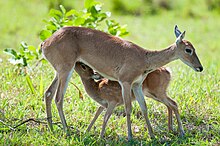Our website is made possible by displaying online advertisements to our visitors.
Please consider supporting us by disabling your ad blocker.
Pampas deer
| Pampas deer | |
|---|---|

| |
| Male Pampas deer in Serra da Canastra National Park. | |

| |
| Female Pampas deer nursing fawn in the Pantanal, Brazil. | |
| Scientific classification | |
| Domain: | Eukaryota |
| Kingdom: | Animalia |
| Phylum: | Chordata |
| Class: | Mammalia |
| Order: | Artiodactyla |
| Family: | Cervidae |
| Subfamily: | Capreolinae |
| Genus: | Ozotoceros Ameghino, 1891 |
| Species: | O. bezoarticus
|
| Binomial name | |
| Ozotoceros bezoarticus | |

| |
| Synonyms | |
|
Cervus bezoarticus Linnaeus, 1758 | |
The Pampas deer (Ozotoceros bezoarticus) is a species of deer that live in the grasslands of South America at low elevations.[3] They are known as veado-campeiro in Portuguese and as venado or gama in Spanish. It is the only species in the genus Ozotoceros.
Their habitat includes water and hills, often with winter drought, and grass that is high enough to cover a standing deer.[4] Many of them live on the Pantanal wetlands, where there are ongoing conservation efforts, and other areas of annual flooding cycles. Human activity has changed much of the original landscape.[5]
They are known to live up to 12 years in the wild, longer if captive, but are threatened due to over-hunting and habitat loss.[6] Many people[who?] are concerned over this loss, because a healthy deer population means a healthy grassland, and a healthy grassland is home to many species, some also threatened. Many North American birds migrate south to these areas, and if the Pampas deer habitat is lost, they are afraid these bird species will also decline.[7] There are approximately 80,000 Pampas deer total, with the majority of them living in Brazil.[8]
- ^ González, S.; Jackson, III J. J.; Merino, M. L. (2016). "Ozotoceros bezoarticus". IUCN Red List of Threatened Species. 2016: e.T15803A22160030. doi:10.2305/IUCN.UK.2016-1.RLTS.T15803A22160030.en. Retrieved 12 November 2021.
- ^ "Appendices | CITES". cites.org. Retrieved 2022-01-14.
- ^ Geist, Valerius. Deer of the world their evolution, behaviour, and ecology. Mechanicsburg, Pa: Stackpole Books, 1998
- ^ P., Walker, Ernest. Walker's Mammals of the world. Baltimore: Johns Hopkins UP, 1991
- ^ Harris, Monica B.; Tomas, Walfrido; Mourao, Guilherme; Da Silva, Carolina J.; Guimaraes, Erika; Sonoda, Fatima; Fachim, Eliani (2005). "Safeguarding the Pantanal Wetlands: Threats and Conservation Initiatives". Conservation Biology. 19 (3): 714–20. Bibcode:2005ConBi..19..714H. doi:10.1111/j.1523-1739.2005.00708.x. S2CID 85322187.
- ^ Moore, Don (2003). "A Delicate Deer". Wildlife Conservation. 106: 6–7.
- ^ Villa, A. R.; Beade, M. S.; Lamuniere, D. Barrios (2008). "Home range and habitat selection of pampas deer". Journal of Zoology. 276: 95–102. doi:10.1111/j.1469-7998.2008.00468.x.
- ^ IUCN Mammal Red Data Book. Gland, Switzerland: IUCN, 1982
Previous Page Next Page



